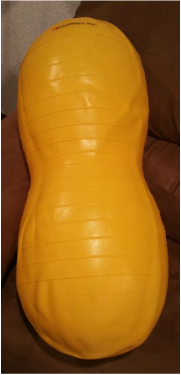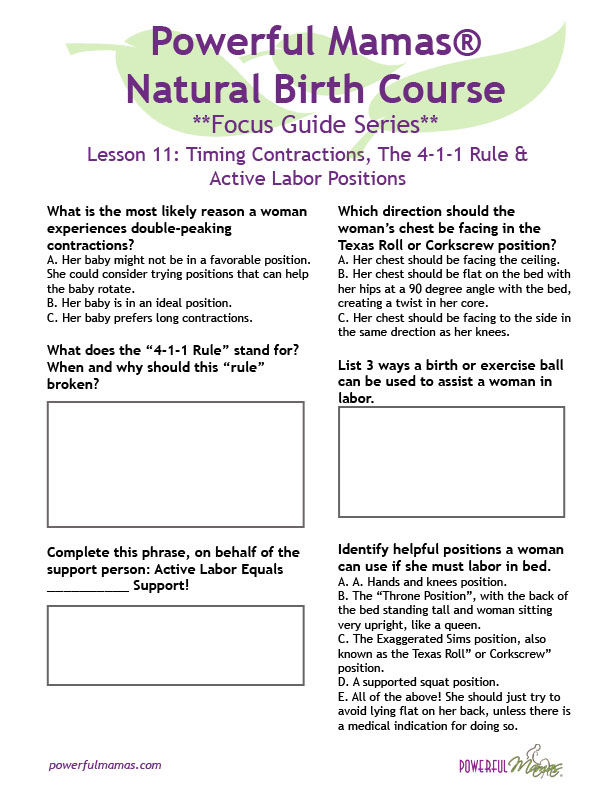Lesson 11: Timing Contractions, The 4-1-1 Rule, & Active Labor Positions
"Speak tenderly to them. Let there be kindness in your face, in your eyes, in your smile, in the warmth of our greeting. Always have a cheerful smile. Don't only give your care, but give your heart as well." ~ Mother Teresa
introduction
 Peanut Balls Work Well as a Back Rest, to Lean Over on the Bed & Between the Legs for the Texas Roll Position! I Prefer the Smallest Size for Most Women Since It Fits Nicely Between the Knees.
Peanut Balls Work Well as a Back Rest, to Lean Over on the Bed & Between the Legs for the Texas Roll Position! I Prefer the Smallest Size for Most Women Since It Fits Nicely Between the Knees.
How do you measure a contraction? When should you go to the hospital, birth center, or have the midwife come to your home birth? What is the 4-1-1 rule, anyway?!?!? Best of all, when are rules meant to be broken?? In other words, is there something (or someONE!) more important that we should be watching, rather than the numbers on a contraction app or the electronic fetal monitor?
Once we better understand contraction patterns and the phases of labor, it's time to learn some popular positions for active labor that will assist in managing pain and encouraging labor to progress.
Don't just watch - PRACTICE along with us, then do your own labor rehearsal using the positions demonstrated in class, as well as the handout, "Nonpharmacologic Pain Management Strategies - Stations"!
Come back to this exercise again and again until you AND your partner feel comfortable using each of these coping techniques. You might even want to put a clothes pin on the inside of your ear cartilage while practicing a contraction with each of these positions; or you can hold a piece of ice to simulate the challenge of feeling discomfort while trying to stay relaxed. Just be sure to remove the clothes pin or set down the piece of ice in between "contractions"! :) Now let's get started!!!
Once we better understand contraction patterns and the phases of labor, it's time to learn some popular positions for active labor that will assist in managing pain and encouraging labor to progress.
Don't just watch - PRACTICE along with us, then do your own labor rehearsal using the positions demonstrated in class, as well as the handout, "Nonpharmacologic Pain Management Strategies - Stations"!
Come back to this exercise again and again until you AND your partner feel comfortable using each of these coping techniques. You might even want to put a clothes pin on the inside of your ear cartilage while practicing a contraction with each of these positions; or you can hold a piece of ice to simulate the challenge of feeling discomfort while trying to stay relaxed. Just be sure to remove the clothes pin or set down the piece of ice in between "contractions"! :) Now let's get started!!!
learning goals & focus guide
 Right Click to Download & Print This Focus Guide!
Right Click to Download & Print This Focus Guide!
After viewing and completing Lesson 11 - "Timing Contractions, The 4-1-1 Rule, & Active Labor Positions", students will be able to:
- Measure the duration and frequency of contractions found in the chart on p. 34 of the Prepared Childbirth manual.
- Name one potential cause of double-peaking contractions, and 2 techniques that may help the woman cope.
- Explain in detail what the "4-1-1 Rule" stands for, then state when and why this "rule" should be broken.
- Finish this phrase as the support person: "Active Labor Equals _________Support!"
- List 4 active labor positions that are good for normal labor, but particularly excellent for back pain.
- Explain 2 benefits of asymmetrical positions, (such as the side lunge, curb-stepping, stairs, or standing with one foot up on a chair and the other foot on the floor.)
- Locate which direction the woman's chest and hips should each be facing in the "Texas Roll", or Exaggerated Sims Position, then state 2 circumstances when this position can be very useful. (What Jacquelyn calls the Corkscrew position!)
- Finish this sentence: "Water can be the midwife or doula's ________"! Then identify what phase of labor the woman should be in before she gets in a birth pool or tub, (assuming she wants labor to continue progressing!)
- Name 4 positions that can be used in a hospital bed, other than lying flat on a woman's back.
- List 3 ways a birth or exercise ball can be used to assist a woman in labor.
- Explain why the hip squeeze operates like a clothes pin.
- Measure the duration and frequency of contractions found in the chart on p. 34 of the Prepared Childbirth manual.
- Name one potential cause of double-peaking contractions, and 2 techniques that may help the woman cope.
- Explain in detail what the "4-1-1 Rule" stands for, then state when and why this "rule" should be broken.
- Finish this phrase as the support person: "Active Labor Equals _________Support!"
- List 4 active labor positions that are good for normal labor, but particularly excellent for back pain.
- Explain 2 benefits of asymmetrical positions, (such as the side lunge, curb-stepping, stairs, or standing with one foot up on a chair and the other foot on the floor.)
- Locate which direction the woman's chest and hips should each be facing in the "Texas Roll", or Exaggerated Sims Position, then state 2 circumstances when this position can be very useful. (What Jacquelyn calls the Corkscrew position!)
- Finish this sentence: "Water can be the midwife or doula's ________"! Then identify what phase of labor the woman should be in before she gets in a birth pool or tub, (assuming she wants labor to continue progressing!)
- Name 4 positions that can be used in a hospital bed, other than lying flat on a woman's back.
- List 3 ways a birth or exercise ball can be used to assist a woman in labor.
- Explain why the hip squeeze operates like a clothes pin.
video lesson
Timing Contractions, The 4-1-1 Rule & Active Labor Positions For Progress & Pain Relief
Audio Only:
A Quick Slideshow Of Comfort Techniques: (If you can't see the slideshow, download the PDF of labor positions listed under the Diving Deeper section instead!)
resources
~ "Prepared Childbirth: The Family Way", By Debby Amis and Jeanne Green (Your Purple Book, pages 20-23, 34, 47, 108-110)
~ "Nonpharmacologic Pain Management Strategies - Stations" From "Prepared Childbirth, the Family Way"
~ "Nonpharmacologic Pain Management Strategies - Stations" From "Prepared Childbirth, the Family Way"
Powerful Mamas® Printable Labor Positions for Your Birth Bag!
(Click HERE to download the pdf version for printing.)
Your browser does not support viewing this document. Click here to download the document.
diving deeper
Want to Dive Deeper? Let's Go!

~ "Physiologic Positions and Movements for Labor and Birth" By Penny Simkin, PT
~ "Evidence on the safety of waterbirth" ~ © 2014 Evidence Based Birth®, Blog Post By Rebecca Dekker, PhD, RN, APRN. Linked with permission.
~ "Evidence-based summary about the safety of waterbirth in response to the controversial ACOG/AAP committee opinion warning that waterbirth has not been proven safe for the baby." ~ Harper, B. (2014). Birth, bath, and beyond: The science and safety of water immersion during labor and birth. Journal of Perinatal Education, 23(3), 124-134.
~Regarding waterbirth, see also: Science and Sensibility blog, Why pediatricians fear waterbirth by B. Harper.
~ "Evidence on the safety of waterbirth" ~ © 2014 Evidence Based Birth®, Blog Post By Rebecca Dekker, PhD, RN, APRN. Linked with permission.
~ "Evidence-based summary about the safety of waterbirth in response to the controversial ACOG/AAP committee opinion warning that waterbirth has not been proven safe for the baby." ~ Harper, B. (2014). Birth, bath, and beyond: The science and safety of water immersion during labor and birth. Journal of Perinatal Education, 23(3), 124-134.
~Regarding waterbirth, see also: Science and Sensibility blog, Why pediatricians fear waterbirth by B. Harper.
Web It! Resources from The Family Way®:

Comfort Positions for Pregnancy and Labor (page 20)
~ Comfort in Labor-How You Can Help Yourself to a Normal Satisfying Childbirth
~ Labor ”On the Ball”
Movements for Labor (page 45)
~ Comfort in Labor
~ Comfort in Labor-How You Can Help Yourself to a Normal Satisfying Childbirth
~ Labor ”On the Ball”
Movements for Labor (page 45)
~ Comfort in Labor
reflection opportunities
|
|
Student Polls: |
Journal Entry:
Please visit the forum below under "Unit 3: Preparing For Labor - Timing Contractions, The 4-1-1 Rule, And Active Labor Positions" to reflect on the following question:
- List 4 active labor positions that are good for normal labor, but particularly excellent for back pain. Also explain 2 benefits of asymmetrical positions, (such as the side lunge, curb-stepping, stairs, or standing with one foot up on a chair and the other foot on the floor.)
- List 4 active labor positions that are good for normal labor, but particularly excellent for back pain. Also explain 2 benefits of asymmetrical positions, (such as the side lunge, curb-stepping, stairs, or standing with one foot up on a chair and the other foot on the floor.)
Please note you must log in to the forum at the beginning of each online session, even after you have already logged into the Class Portal. Click below on "Powerful Mamas Online Student Forums" to access this feature:
Inspiring Birth Stories!
"When preparing to become parents for the first time, my husband and I thought it would be exciting to wait to find out the sex of our baby, so as our due date approached we became more and more anxious to find out and meet our little one. We didn’t have to wait long. At 39 weeks along, after a good workout at the gym, I went to the bathroom and noticed I had lost my mucus plug. Then at 6:30am the next morning I woke up to my water breaking! Contractions didn’t start right away, so I thought (amateur mistake) that I could go ahead and go into work for the day, or until labor really got going. Thankfully, my husband reminded me that I was having a BABY that day and should probably just get ready for that.
About 30 minutes later my contractions started. I was surprised at how intense they were, much worse than menstrual cramps, which somewhat scared me. I was thinking early labor would be mild cramping, not bending over in pain. I wanted to have a natural, unmedicated labor if at all possible, so we had an OBGYN who was very supportive of that and we also had a doula who would help us through the labor with alternative pain relief options. I called our doula and she assured me that my water breaking may cause the contractions to feel more intense right away and suggested I use the birthing ball and have my husband use counter-pressure to find some comfort during contractions.
By 11am, my contractions were only a few minutes apart and I was struggling to talk through them. So we left for the hospital and once we arrived things got kind of blurry for me because I had blocked out my surroundings and was just focusing on breathing through the pain. I was 4 cm dilated and 80% effaced at 11:30am. My OBGYN had just finished her 24-hour shift, but when she saw me check in, she agreed to stay at the hospital so she could deliver our baby (she was the sweetest!) I had my eyes closed most of the time to focus on my breathing and trying not to become overwhelmed by the pressure in my back and abdomen. Our doula suggested I labor in the tub with warm water to relax my muscles and find some pain relief. I found the warm water to help, but at that point I was in the final stage of labor and the contractions were one on top of the other. I “shhhhh’d” through each wave of sheer pain as my husband encouraged me that my body was made for this and the pressure I was feeling was my body making space for our baby to come out. With every contraction we got closer to meeting our child.
Fortunately, I was only at the hospital for 2 hours when I felt a deep burning pain and my doula informed me that it was time to get out of the tub because that meant baby was coming! The OB checked me to see if I was fully dilated and actually saw our baby’s head right there! Before any nurses could get supplies ready or my OB could get in her scrubs, I felt an overwhelming urge to push and after a few contractions and big pushes, our precious baby was born! My husband announced “It’s a BOY!” I remember being surprised at how good it felt to push and I wasn’t feeling any pain at that point. Just felt pure joy, relief, gratitude, and excitement to deliver a healthy baby boy. It still amazes me to think how God created our bodies to do something so incredible – to grow, nurture, and deliver another human life into the world." - Jill T.
About 30 minutes later my contractions started. I was surprised at how intense they were, much worse than menstrual cramps, which somewhat scared me. I was thinking early labor would be mild cramping, not bending over in pain. I wanted to have a natural, unmedicated labor if at all possible, so we had an OBGYN who was very supportive of that and we also had a doula who would help us through the labor with alternative pain relief options. I called our doula and she assured me that my water breaking may cause the contractions to feel more intense right away and suggested I use the birthing ball and have my husband use counter-pressure to find some comfort during contractions.
By 11am, my contractions were only a few minutes apart and I was struggling to talk through them. So we left for the hospital and once we arrived things got kind of blurry for me because I had blocked out my surroundings and was just focusing on breathing through the pain. I was 4 cm dilated and 80% effaced at 11:30am. My OBGYN had just finished her 24-hour shift, but when she saw me check in, she agreed to stay at the hospital so she could deliver our baby (she was the sweetest!) I had my eyes closed most of the time to focus on my breathing and trying not to become overwhelmed by the pressure in my back and abdomen. Our doula suggested I labor in the tub with warm water to relax my muscles and find some pain relief. I found the warm water to help, but at that point I was in the final stage of labor and the contractions were one on top of the other. I “shhhhh’d” through each wave of sheer pain as my husband encouraged me that my body was made for this and the pressure I was feeling was my body making space for our baby to come out. With every contraction we got closer to meeting our child.
Fortunately, I was only at the hospital for 2 hours when I felt a deep burning pain and my doula informed me that it was time to get out of the tub because that meant baby was coming! The OB checked me to see if I was fully dilated and actually saw our baby’s head right there! Before any nurses could get supplies ready or my OB could get in her scrubs, I felt an overwhelming urge to push and after a few contractions and big pushes, our precious baby was born! My husband announced “It’s a BOY!” I remember being surprised at how good it felt to push and I wasn’t feeling any pain at that point. Just felt pure joy, relief, gratitude, and excitement to deliver a healthy baby boy. It still amazes me to think how God created our bodies to do something so incredible – to grow, nurture, and deliver another human life into the world." - Jill T.

